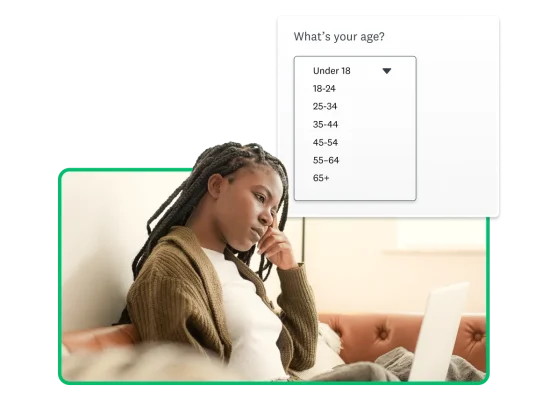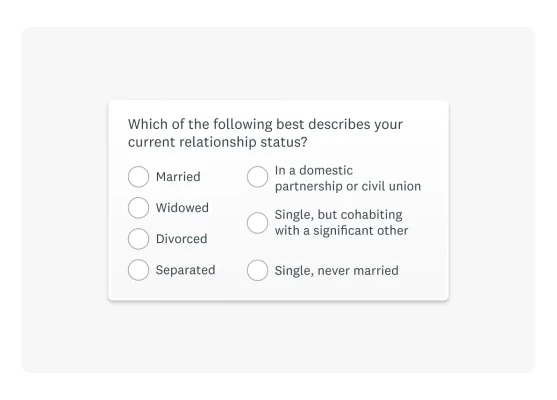Demographic survey question guide: Tips, examples and best practices
Gain valuable insights and understand your audience with 13 demographic survey questions and examples.

Summary:
You can ask demographic questions about age, gender, ethnicity, income, education, marital status or occupation. In this article, we’ll discuss 13 example questions and potential answer options, use cases for your demographic data and some best practices around how to collect this data.
Where do you live? What do you do? How much do you earn? Please excuse the personal questions, but gathering demographic information is a great way to understand your audience better.
Demographic information can help you understand and segment your audience according to characteristics such as age, income level, education and geographical location. You can use this data to personalise your messaging, create unique customer experiences and design more customer-aligned products.
In this comprehensive guide, you’ll learn what demographic information is, why it’s important to capture and how to craft demographic questions.
Types of demographic questions you can ask in surveys
Demographics are distinct traits or attributes that are used to categorise a group of people according to specific criteria, such as age, gender, income level, education, ethnicity, marital status and employment.
Demographic information helps researchers identify trends and patterns within a population. Businesses can use this information to make more informed decisions about everything from marketing strategies to product roadmaps.
Here are a few examples of different types of demographic data:
- Age Groups: 18–24, 25–34, 35–44, etc.
- Gender: Male, Female, Non-binary, etc.
- Ethnicity/Race: White; Black, Black British, Caribbean or African; Mixed or multiple ethnic groups; Asian; etc.
- Education: Completed secondary school, Bachelors degree, Masters degree, Doctorate, etc.
- Income: <£20,000, £20,000–£40,000, £40,001–£60,000, etc.
- Marital Status: Single, Married, Divorced, Widowed
- Occupation: Categories could include Healthcare, Education, Information Technology, Retail, etc.

Capture data from a specific demographic using our online panel to select survey respondents.
13 demographic survey questions and examples
SurveyMonkey also has many expert-designed survey templates that you can use or reference to build your own customised questionnaire.
You can use certified questions from the Question Bank to add a few demographic questions to a survey. This is a common practice and a good option for including specific questions in a larger survey.
Here are a few examples to get you started.
1. Age
One of the most commonly asked demographic questions is about the age range. Age is sometimes a necessary piece of information in market research segmentation, medical research, customer identification and more.
Age-related demographic questions allow you to segment your audience so you can craft personalised strategies for each age group. Audience segments also help predict future trends in terms of your customers’ needs.
Example: Which category includes your age?
- 17 or younger
- 18–20
- 21–29
- 30–39
- 40–49
- 50–59
- 60 or older
There are many ways to list age group ranges for surveys. Some researchers organise data into five- or ten-year periods. Others group data by generation, such as Baby Boomers, Millennials, Gen X and Gen Z. The range you use is up to you and depends on what will work best with your survey goals.
Tips for asking about age range
Because age can be a sensitive issue, follow these tips for asking your survey respondents age-related questions:
- Explain why you’re asking for age demographics. Let survey respondents know the question is coming and help them understand the context of the sensitive question.
- Tell participants how you will use the information they provide. A brief statement is plenty. This is also a good place to explain how you’ll protect their privacy.
- Put the age range demographic survey question at the end of the survey. Age questions feel less invasive when placed towards the end of a survey rather than at the beginning.
2. Ethnicity
Asking about ethnicity in surveys can provide valuable insights into your audience’s diverse cultural backgrounds, preferences and needs. This information can also help you identify strategy gaps and create more inclusive strategies and products.
Example: How would you describe your ethnicity?
- White
- Black, Black British, Caribbean or African
- Asian
- Native/Indigenous
- From multiple races
- Some other race (please specify)
- Prefer not to disclose
Pro tip: For demographic questions like the last one, it’s a good idea to add an “Other (please specify)” answer option. This type of answer option gives respondents a text box to self-identify.
3. Gender
Gender questions in surveys can help you understand the diverse perspectives and experiences of different genders within your target audience. After all, products and services that women like may not appeal to men or non-binary people and vice versa.
Example: What is your gender?
- Female
- Male
- Non-binary
- Prefer not to disclose
- Other (specify)
Note that the last question requires a text box for the respondent to self-identify.
4. Marital status
Researchers ask about marital status to learn about people’s needs and preferences based on their life stage and social situation. It can help researchers tailor services and products to better meet people’s needs.
For example, a travel company might offer different package deals to singles, couples and families, recognising that their ideal holidays will be very different. Similarly, financial service providers can create targeted offerings catering for the unique financial planning needs of singles, married couples or people going through a divorce.
Example: Are you married, widowed, divorced, separated or never been married?
- Married
- Widowed
- Divorced
- Separated
- Never married
5. Education
Asking about the education level in demographic surveys can provide valuable insights into the knowledge base, skills and, potentially, the earning power of your audience.
Example: What is the highest level of education you have completed or the highest degree you have received?
- Fewer than 5 GCSE passes at grade C or higher or equivalent
- 5 GCSE passes at grade C or higher or approximately equivalent qualification (e.g. BTEC First Diploma)
- Some university but no degree
- Associate degree
- Bachelors degree
- Postgraduate degree (e.g. Masters, PhD, MD)
6. Employment
Employment status can give you an insight into the economic situation of your audience, which can significantly influence their purchasing behaviour, needs and priorities. However, this can be a sensitive question. Give respondents the option to skip the question if necessary.
Here’s an example of an employment demographic question:
Example: Which of the following categories best describes your employment status?
- Employed part-time
- Employed full-time
- Unemployed, looking for work
- Unemployed, not looking for work
- Retired
- Disabled, unable to work
- Prefer not to disclose
7. Household income
Household income combines the earnings of everyone living in the same home. Collecting this data helps you understand your customers’ purchasing power. Ask for this sensitive information using income ranges and include an option for respondents to skip the question.
Example: What was your combined household income in the last year?
- £0–£9,999
- £10,000–£19,999
- £20,000–£29,999
- £30,000–£39,999
- £40,000–£49,999
- £50,000–£59,999
- £60,000–£69,999
- £70,000–£79,999
- £80,000–£89,999
- £90,000–£99,999
- £100,000 or more
- Prefer not to disclose
8. Living Situation
Living situation describes whether a customer owns their home, rents a property or has another living arrangement. Understanding a customer’s living situation helps you gauge the stability of their current location.
Example: Which of the following best describes your current living situation?
- Own my home
- Rent my home
- Other (please specify)
- Prefer not to disclose
9. Language
Asking about language in demographic surveys helps identify the primary language that a respondent speaks at home. This can give you an insight into your audience’s communication preferences, which means you can make sure your messages are accessible. Language data can also help you define your marketing localisation and translation strategy to ensure that your communications are culturally relevant and appropriately targeted.
Example: Which language do you mainly speak at home?
- English
- Polish
- Romanian
- Punjabi
- Some other language (please specify)
10. Family and dependents
Family and dependent questions tell you the number of children under 18 living in your customer’s household. This can give you insights into your customer’s priorities and challenges.
For example, if you learn that most of your customers have several young children, you can use this information to tailor your offerings and messaging to appeal directly to the challenges and priorities of parenting and family life.
Example: How many children are you a parent or guardian to who live in your household (aged 17 or younger only)?
- None
- 1
- 2
- 3
- 4
- More than 4
11. Media consumption preferences
Media consumption preferences can help you understand where your audience gets their information from. This question can help you understand the type of content your audience consumes and on what platforms. In turn, you can place ads and content strategically.
Example: Where do you currently get your news from about politics?
- Television
- Radio
- Newspaper - hard copy
- Newspaper - online
- Magazines - hard copy
- Magazines - online
- Internet blog
- Internet news site
- Other (please specify)
12. Religion
Asking about religion in demographic surveys helps you understand the diverse belief systems and spiritual backgrounds within your audience. Understanding this data can help you customise your content or product to suit the specific religious traditions of your target audience.
With personal questions like this, just remember that you should be respectful and let respondents opt out if they’re not comfortable sharing.
Example: Do you identify with any of the following religions? (Select all that apply.)
- Protestantism
- Catholicism
- Christianity
- Judaism
- Islam
- Buddhism
- Hinduism
- Inter/Non-denominational
- No religion
- Other (please specify)
- Prefer not to disclose
13. Political affiliations
Understanding your customers’ political affiliations can give you an insight into their values and priorities. It can also help you create messaging and product offerings that resonate with their world views.
In addition, knowing your customers’ political affiliations can help you avoid any messaging that could potentially alienate your audience. Again, when asking about sensitive topics, be thoughtful and give people the option to not answer if they don’t want to share.
Example: How would you describe your political viewpoints?
- Very liberal
- Slightly liberal
- Moderate
- Slightly conservative
- Very conservative
- Prefer not to disclose
How to use demographic data in your business

You can use demographic information for a variety of use cases, from marketing to business development and product planning. Demographic data increases the likelihood of your messages and products resonating with your target audience.
Imagine if you knew that most of your audience are wealthy married men. Your marketing strategy for this group would be completely different from a marketing strategy aimed at, for instance, young single women at university. Your message and product must always be tailored to appeal to the target demographic because understanding your audience is crucial for business success.
Here are a few powerful ways in which you can use demographic data in your business.
Develop buyer personas
A buyer persona represents your buying audience. A buyer persona helps you understand your ideal customer by breaking down their preferences, dislikes and shopping behaviours.
Identify trends
Market change is inevitable, but you’re not defenceless to it. Demographic questions help you identify market trends and adjust your business to stay ahead of market change.
Confirm the validity of responses
The use of demographic questions helps you target the right buying audience. For instance, you might discover that women like your product more than men do.
9 best practices for collecting demographic data
Think about a time when you had to fill out a form at the bank or a registration form for an activity. You probably shielded the form from prying eyes or even placed the paperwork face down after completing it. Why? Demographic data is personal and identifies information that you may not want to make public.
This is why it’s vital to use best practices when building a survey that collects demographic information. The following tips will help you drive high completion rates and obtain high-quality data.
1. Start by establishing your objectives
Before launching any survey, it is critical to set clear objectives. Defining what you need to learn from the demographic information will help you tailor your questions. The responses you collect from goal-specific questions will be relevant and actionable.
2. Clarify the purpose of the survey
Explain the purpose of your survey. In a brief introduction, tell your respondents how you’ll use the information. For example: “We want to know more about our customers and what they want. This information will help us put together the right mix of products and services to ensure your satisfaction.”
3. Keep the survey short and to the point
It can be tempting to ask a lot of demographic questions, but don’t add too many! If your survey is too long, respondents can get survey fatigue. This can result in lower-quality responses. The respondent might also abandon the survey altogether. Instead, master the art of concise surveys to increase completion rates and ensure data quality.
4. Be respectful
Be mindful of your audience. Demographic questions deal with personal details about the respondent’s identity, such as gender, income, living situation or even religious and political affiliations. Keep your language inclusive. Additionally, consider giving respondents the option to not disclose information if they so choose.
5. Use easy-to-understand language
Your survey should be comprehensible. This not only makes sure you’re obtaining quality data, but it also improves survey completion rates. So keep your questions simple, straightforward and free of jargon.
6. Understand how (and when) to ask sensitive questions
Know when to get personal. Like an in-person conversation, establish a rapport with your respondent first before asking them about personal matters.
7. Watch out for overlapping numbers
Many demographic questions ask respondents to choose a range of numbers that best describes them, such as an age range or income bracket. Make sure these numbers don’t overlap. For example, if one age bracket covers 50 to 59 years old, make sure the next one starts at 60 rather than at 59. This will ensure that you obtain accurate data and avoid confusing your respondents.
8. Consider making responses anonymous
Many people are sensitive about disclosing their personal information. Demographic information examples where this can ring true include income level, employment status, race and ethnicity. If you are studying general trends, make sure responses are anonymous and inform participants of this.
9. Make your survey accessible and mobile-friendly
Your survey should be easy to complete for anyone regardless of who they are or how they complete the survey. Use survey templates accessible by U.S. Section 508 standards and The European Accessibility Act. Additionally, ensure that your survey works across different devices, including phones, tablets and computers.
The benefits of asking demographic questions in surveys
Although asking customers personal questions in surveys may seem daunting, demographic data brings many benefits. Read about a few noteworthy demographic data benefits.
Improve personalisation and targeting
One of the primary benefits of demographic survey questions is the ability to personalise your marketing efforts, product development and customer service strategies.
Understanding your audience helps you customise your messages and products to meet their specific needs, preferences and challenges. This means that you can serve different customer groups more effectively. And personalising your offerings can improve engagement, conversion rates, brand relevance and customer satisfaction.
Related: Marketing demographics
Inform your strategic decision-making
Demographic insights can help you identify market trends, anticipate changes in consumer behaviour and uncover new opportunities for growth. In turn, you can make data-informed decisions about a new product feature, service expansion or price adjustment, for instance, that align with your target audience.
Increase marketing efficiency and ROI
Adding demographic questions to surveys can help you use your marketing budget more wisely and increase your return on investment (ROI). Knowing your customers’ demographics, origins and preferences can help you create focused marketing strategies for better results.
You have a better chance of reaching and resonating with your intended audience if you use targeted campaigns. As a result, you can achieve better outcomes with your marketing spend, including higher conversion rates.
6 demographic survey templates
Now that you’ve seen what sample demographic questions actually look like, you can check out some ready-to-use demographic survey templates.
The following are templates, which include demographic survey questions, straight from the minds of SurveyMonkey’s expert survey methodologists:
* Please note that some demographics survey templates are currently only available in English.
1. U.S. demographics, snapshot template
This six-question template asks respondents about gender, age, education, employment, household income and race. View U.S. demographics, snapshot template.
2. U.S. demographics, full template
In addition to the six questions posed in the Snapshot Template, this 12-question template asks about geographical location, housing, marital status, ethnicity, business or farm ownership, and personal income. View U.S. demographics, full template.
3. Employment template
With two quick questions, learn about respondents’ employment status and the type of work they do. View employment template.
4. Education demographics template
Discover the makeup of your academic community with 16 basic demographic questions about gender, income, race, relationship to student and more. View education demographics template.
5. Firmographics template
Learn more about the companies on your customer list with this 10-question survey that asks when the company was founded, where it’s headquartered, the number of employees and locations, and more. View firmographics template.
6. Target market demographics template and typical customer demographics template
These B2B survey templates help your business clients understand their end customers. Demographic questions include age, gender, education level, employment status, annual household income, marital and family status, housing, business and farm ownership. View target market demographics template and typical customer demographic template.
Frequently asked questions
- Why are demographic questions used in surveys?
- Where should demographic questions be placed in a survey?
- How does asking demographic questions benefit research?
Ready to use demographic questions in your surveys?
With this comprehensive guide to demographic questions, you’re ready to survey your audience. Start your own survey now. To create multiple surveys and gain access to various SurveyMonkey tools, choose the plan that’s right for you.
Discover more resources

Toolkits Directory
Discover our toolkits, designed to help you leverage feedback in your role or industry.

What is a questionnaire? Definition, examples and uses
Learn how to use questionnaires to collect data to be used in market research for your business. We share examples, templates and use cases.

Create employee exit interview forms to know where to improve
Ask the right questions on your exit interview survey to reduce employee attrition. Get started today with our employee form builder tools and templates.

Receive the necessary permissions with online consent forms
Get the permissions you need with a custom consent form. Sign up for free today to create forms with our consent form templates.